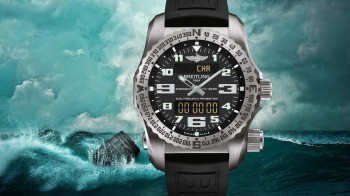Because it was reserved for a secret elite, the Breitling Emergency has always been something of a secret itself. And yet there’s no real logic to this injustice. Back in 1988, a NATO officer suggested to Breitling’s CEO: “Couldn’t we have a transmitter that can be worn on the wrist in the event of a plane crash or shipwreck? Like a watch?” Ernest Schneider took him at his word: “In a watch?” And that became the brief for the Emergency watch. It became the world’s first watch to contain a transmitter that enabled its wearer to be located by satellite. Was this perhaps the world’s first connected watch?
Three hurdles to overcome
Its birth was by no means an easy one. As for any project that breaks new ground, there were several technical obstacles to overcome – three of them, in fact. The first was miniaturising the transmitter. The watch that contained it had to be wearable – not the size of a frying pan. The result was a respectable 51 mm. Mission accomplished, but not without the crucial assistance of Dassault Electronique, the French aviation and military equipment giant that collaborated on the module.

The second obstacle was maximising the duration of the distress signal. Here, we come up against one of the classic dilemmas of onboard electronics: do you go for a high-intensity signal with a shorter duration, or a weaker signal that lasts longer? Breitling succeeded in designing a transmitter that could broadcast for between 18 and 24 hours, depending on temperature. The second version of the Emergency, introduced in 1995, pushed the autonomy of the transmitter up to a maximum of 48 hours in normal conditions, thanks to a new patent. The new collection has dispensed with the removable battery in favour of a rechargeable battery with a docking station. It also handles two transmission frequencies: the traditional 121.5 MHz, and 406.040 MHz. Satellites now only receive on the latter frequency, but Breitling has retained the former in its Emergency in order to improve geolocation opportunities for potential victims.

So that brings us to the third obstacle: the ability to wear the transmitter on the wrist without triggering it accidentally, along with the rescue teams! Breitling opted for a folding antenna that deploys after unscrewing a screw-down crown, which limits the possibility of user error.
Discreet and robust
Emergency has survived the three decades since its birth in 1988, and remains with us today. Not only has it survived the decades, it has also survived changes in management, collections and owners. The Emergency has remained on the books of Breitling’s new management team, led by Georges Kern, who is now betting strongly on vintage models. And in this respect, the Emergency is certainly earning its keep! First, in terms of image: Breitling owns the patented technology that powers it, and which perfectly sums up its advertising slogan: “Instruments for professionals.” The tagline has gone, but the spirit remains, as does the Emergency. And second, in terms of the lives it has saved. It’s difficult to get hold of concrete statistics, but it seems that there could be around sixty people who owe it their lives.

Some 40,000 units have been produced, the watch’s success no doubt helped by the almost complete absence of competition. The Emergency was one of the first connected watches, and it was also among the first to offer an additional service, on top of the time and the usual complications such as a chronograph. Today, all smartwatches offer additional services (activity tracking, sleep tracking, notifications, etc.), but it’s interesting to remember that, 30 years ago, it was the Emergency that paved the way.






